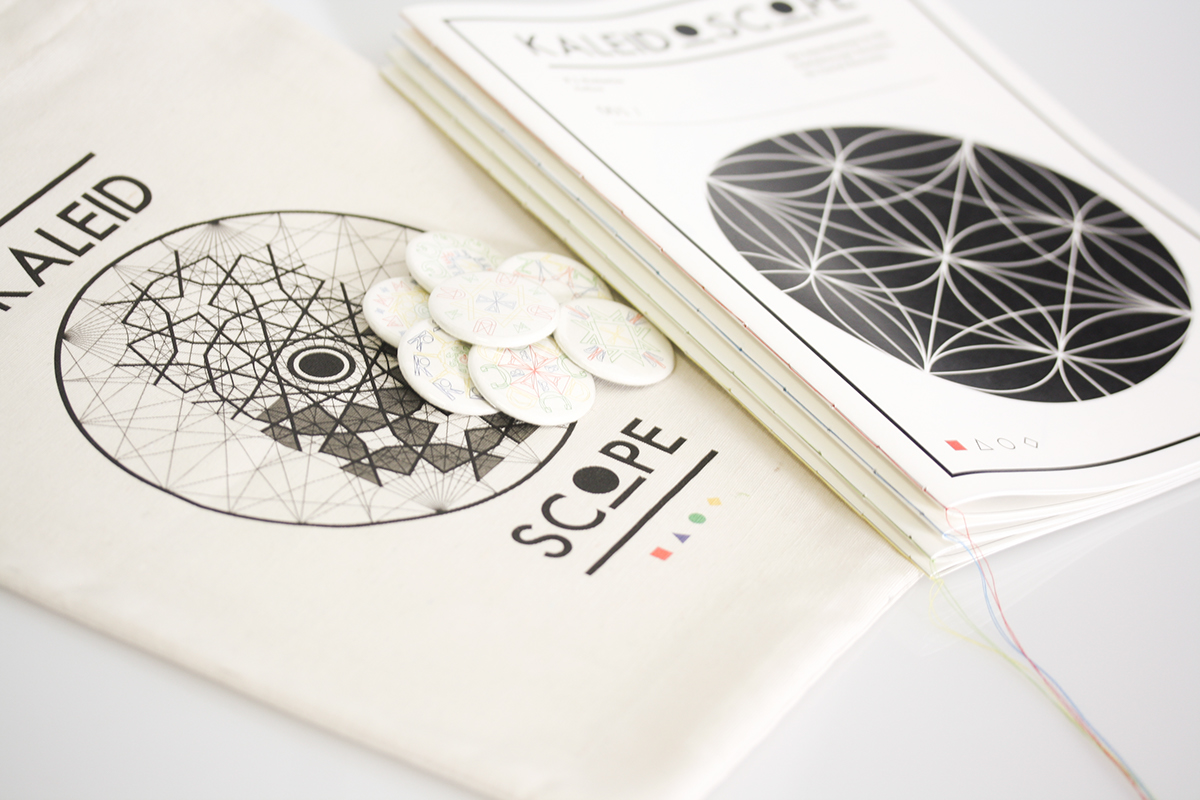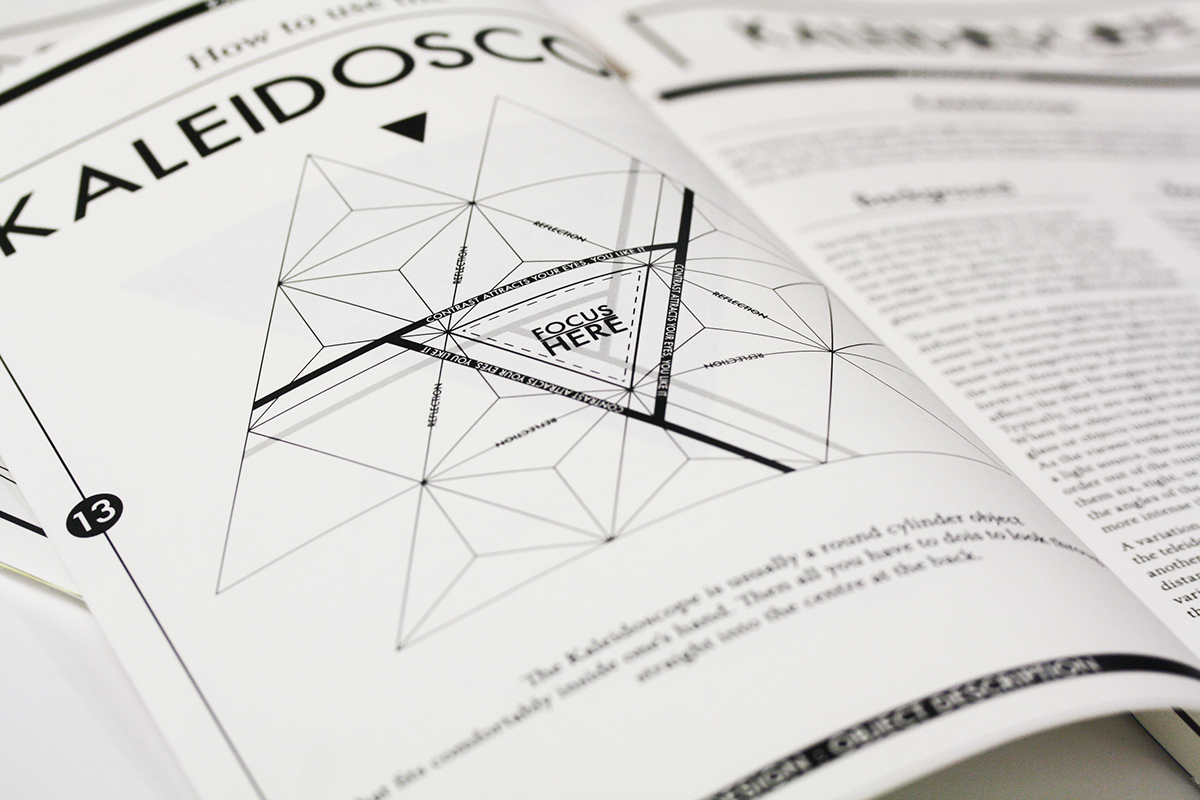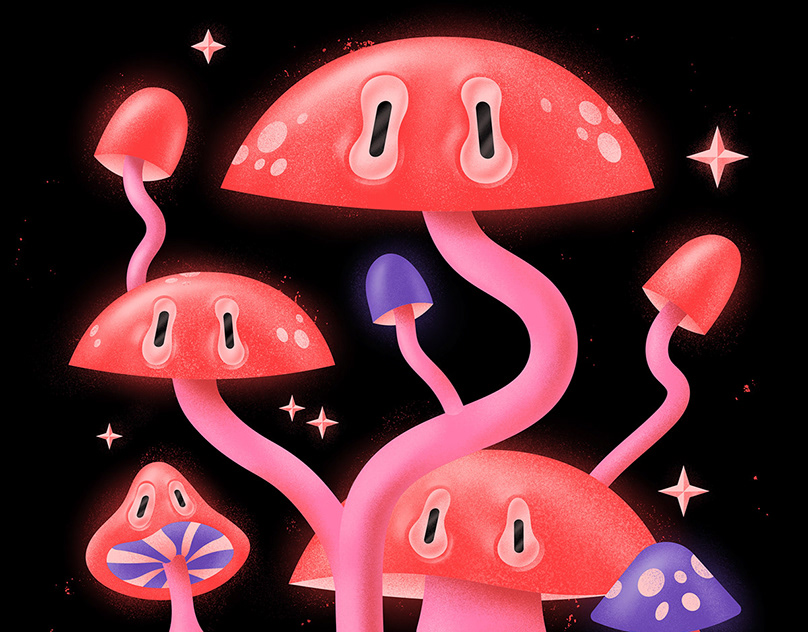THE BRIEF:
This project was about publication and designing with typography. The theme of the project was: “Everything about one thing”.
THE STRATEGY:
After reading and analysing the ISTD 2014 brief, I chose the "Everything about one thing" student assessment project. The Brief clearly stated to first gather information on one specific topic and to bring it forth in either a digital medium or print medium. I decided to choose print medium because it creates a tangible experience, which in my opinion, makes my project more personal. After a great deal of primary research on interesting topics, I decided on "Kaleidoscope" as my topic.
The kaleidoscope object always intrigued me. The fact that it has always been an interesting object to me and still does after doing all this research, made it my choice. As Graphic design student and being aware of trends in the design and art industry, I also chose kaleidoscope because I know that combining type with the kaleidoscope look and feel, would create a visually pleasing project for my portfolio. The brief also stated to look at the topic from a different, never before seen perspective, and so I did, by making the whole book monochromatic giving the imaginative reader the chance to mentally add colour to the pages and complete the book by imagination.
The brief also stated that I had to consider the relationship between text and images, and so I did by creating a delicate balance between complex graphics and less complex typography. Balance was created in the book by making the body copy less complicated, using only a one- and two column grid systems. The typography combined with imagery, as you will see in section 3 of my 4 -part book series, was more manipulated and complex.
After alot of research on typography and typography terminology, I began my research concerning kaleidoscope. I started off, by searching for the root and origin of the kaleidoscope and came across the inventor Sir David Brewster. Section 1 is entirely about Sir David Brewster, his story and the way he
saw things through the looking glass. The reason I made a whole section about Brewster, is because I want the reader to know the importance of the person behind the object before they know all about the object itself. This is due to the fact that if It wasn't for Sir David Brewster, there would not have been
a kaleidoscope.
saw things through the looking glass. The reason I made a whole section about Brewster, is because I want the reader to know the importance of the person behind the object before they know all about the object itself. This is due to the fact that if It wasn't for Sir David Brewster, there would not have been
a kaleidoscope.
The second section is about the object, the third about artists who was inspired and influenced by the kaleidoscope and who has made an impact in the art and design industry (This whole section was made up
and is not theoretically accurate). The last and forth section is about me as author and writer, portraying my own view on kaleidoscope. Throughout the book I used a circle to introduce each section and all the graphics
and type has a circular / centred notion to it.
and is not theoretically accurate). The last and forth section is about me as author and writer, portraying my own view on kaleidoscope. Throughout the book I used a circle to introduce each section and all the graphics
and type has a circular / centred notion to it.
The reason why I used a circle through the book is because of the fact that when you look through the peeping hole in a kaleidoscope (the object), it creates a round outline. The self-made display font I created in section 4 was Inspired by "reflection" and "multiplying", because without the above mentioned, kaleidoscope would not have been possible.
THE TARGET MARKET:
This 4 Part book series on kaleidoscope is aimed at a free spirited Niche Market known as hipsters from generation Y. Generation Y is also known as Millennials, born in the late 1970's to late 1990's. This group is now entering the work force. To break the target market down even further I focused on Generation Y hipsters with an interest in graphic design and art on kaleidoscope.
DEMOGRAPHICS:
Age:
25 - 40 Years
Location:
not applicable because my target market is not defined by one place, because they travel.
not applicable because my target market is not defined by one place, because they travel.
Gender:
Unisex
Unisex
Income Level:
LSM of 8-10*
LSM of 8-10*
Education Level:
Post Matric / College / University / first years in the working force
Post Matric / College / University / first years in the working force
Marital or Family Status:
not applicable
not applicable
Occupation:
Designer, Artist, Writer, Entertainment Industry
Designer, Artist, Writer, Entertainment Industry
Ethnic Background:
not applicable because any ethnic group can relate to art and design.
not applicable because any ethnic group can relate to art and design.
*The SAARF LSM
(Living Standards Measure) has become the most widely used marketing research tool in Southern Africa. It divides the nation into 10 different groups (10 Highest - 1 lowest). It's a different way of
segmenting South African Citizens according to their living standards, using criteria such as ownership of cars and major appliances. A LSM of 8-10 is thus a middle class person with an income of R13 698 - R29 512.
(Living Standards Measure) has become the most widely used marketing research tool in Southern Africa. It divides the nation into 10 different groups (10 Highest - 1 lowest). It's a different way of
segmenting South African Citizens according to their living standards, using criteria such as ownership of cars and major appliances. A LSM of 8-10 is thus a middle class person with an income of R13 698 - R29 512.
PSYCHOGRAPHICS:
Personality:
Adventurous, Confident, Unique, Innovators, Unpredictable, Adapt Rapidly, Crave Change and Challenge, More Accepting, Prone to Experimentation, Feeling of Entitlement, Influencers, Seek Balance, Independent, Individualists, Impatient
Adventurous, Confident, Unique, Innovators, Unpredictable, Adapt Rapidly, Crave Change and Challenge, More Accepting, Prone to Experimentation, Feeling of Entitlement, Influencers, Seek Balance, Independent, Individualists, Impatient
Attitudes:
Want to Change the world for the better. Against the mainstream system. Open-minded
Want to Change the world for the better. Against the mainstream system. Open-minded
Values:
On Personal Relations. Diversity. Place value on what others say.
On Personal Relations. Diversity. Place value on what others say.
Interests/Hobbies/Lifestyles:
Millennials take part in 4 - 5 activities. They connect with others through activities and interests. They love spending time alone as well as doing what they love. They love doing sporting activities; Biking. Bowling.
Photography. Millennials want rewards for the things they do.
Millennials take part in 4 - 5 activities. They connect with others through activities and interests. They love spending time alone as well as doing what they love. They love doing sporting activities; Biking. Bowling.
Photography. Millennials want rewards for the things they do.
Behaviour:
Impulsive, "I am my brands". Process info quicker. Tire quicker, short attention span. Self Publishers. Use media to gain control. Prefer short lived experiences. Never bored. Constantly occupied.
Impulsive, "I am my brands". Process info quicker. Tire quicker, short attention span. Self Publishers. Use media to gain control. Prefer short lived experiences. Never bored. Constantly occupied.
How will the product fit on to the target markets lifestyle ?
The Book consists of a 4 part series and is a collectors, non commercial item. The reason the
product fits in with my target market, is because of my target market's "against the system" outlook on life.
The Book consists of a 4 part series and is a collectors, non commercial item. The reason the
product fits in with my target market, is because of my target market's "against the system" outlook on life.
How often will they use the product ?
Not that much, it was meant to be a collectable. The binding is also hand stitched, which makes it very valuable and fragile.
Not that much, it was meant to be a collectable. The binding is also hand stitched, which makes it very valuable and fragile.
What mass media mediums do this group turn to ?
Print and Digital.
Print and Digital.
Are there enough people that fit my criteria ?
Yes. According to research, there is about 80 million individuals in generation Y worldwide.
Yes. According to research, there is about 80 million individuals in generation Y worldwide.
Will my target market benefit from my product ?
Yes; because it is very educational but less formal than just a normal text book. It is a creative, unique,
Yes; because it is very educational but less formal than just a normal text book. It is a creative, unique,
non-commercial approach to learning about a certain topic.
Will they (Identified target market) see a need for it ?
Yes. It is an art Item in itself and it is about new non-commercial contemporary artists.
Yes. It is an art Item in itself and it is about new non-commercial contemporary artists.
Can my target market afford my product ?
Yes, as previously stated, the target group's living standard measure is 8.
Yes, as previously stated, the target group's living standard measure is 8.

the logo.

the colour scheme.

the bag, the badges and the booklets.

binding: all four books are hand stitched with the four main colours. each section of the four part booklet series is represented by a colour and a shape.

the four diffirent covers of the four booklets.

the index page: the index is on the first page in the first booklet.

the first heading in the first booklet.

representation sketch on how to use the kaleidoscope.

one of the artist biography spreads. there are four artist spreads in the third booklet.

Thank You :))




